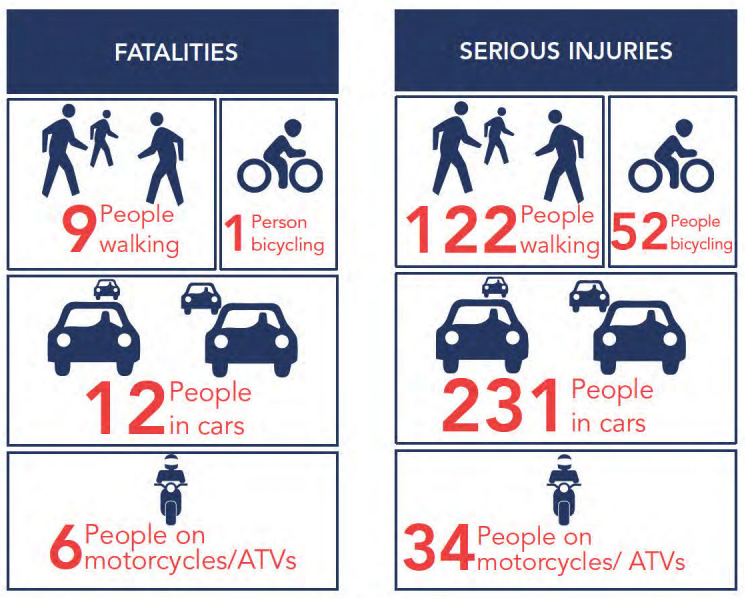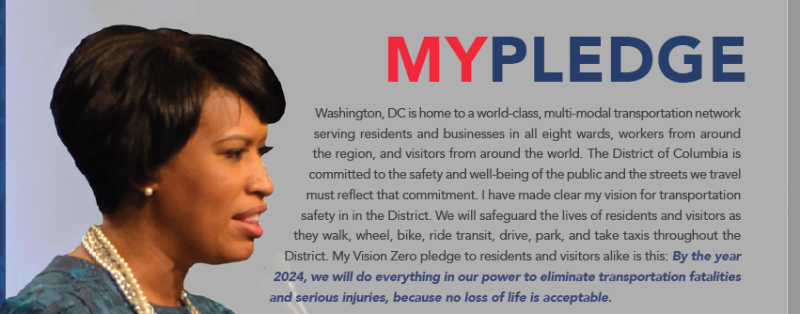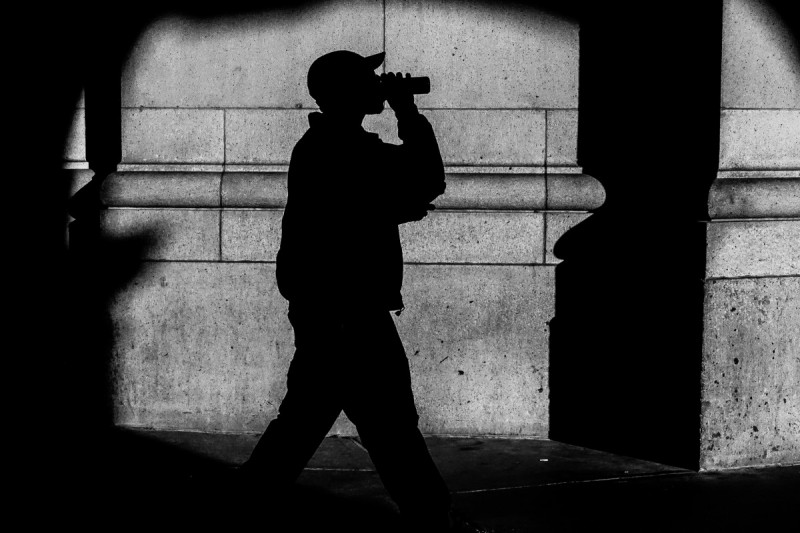What DC needs to do if it really wants zero road deaths

Image by Kristine Marsh used with permission.
It would be inaccurate to say that DC hasn't done anything to get to Vision Zero. It put together an action plan. It hired a manager for the Vision Zero initiative. There are regular meetings, both public and internal. There have been grants and some street improvements.
They even put out a one-year progress report, which reported real steps they've taken and some things, like sobriety checkpoints, that they were already doing. (You can read more of what they've done in DDOT's 2018 oversight testimony).
DC has accomplished some good, but modest, things for which they should be commended. But what has been accomplished isn't up to the task of reducing deaths and injuries by 35% per year.
Furthermore, it hasn't yet implemented all of the strategies it identified in the low-ambition action plan. Every one of the strategies had a target completion date of 2016 or 2017, so they should all be completed.
DC's Vision Zero goal is big, but its effort is small
Without going through them all, it's clear that they aren't. For one thing, CaBi Safety data is not posted on the Vision Zero website. And there is still no progress report for 2017, even though the 2016 report came out 16 months ago. The 2016 report does give an update on all the strategies and many had been completed by then, but many others had not.
Graphic by DC’s 2016 Vision Zero report.
I'll further note that the Vision Zero website doesn't appear to have been updated since 2015, though new information has been posted at DDOT's site. Updating the website won't likely save any lives, but allowing it to linger for three years is not confidence-building.
In addition to those strategies, DDOT proposed a list of regulatory changes like higher traffic fines and expanding the time that school zone speed limits would be in place to 24 hours a day, every day. Those have been scaled back because of public pressure (for example the proposal for school safety zones has been changed from 24/7 to 7 am to 11 pm, and many of the fines have been reduced), which doesn't really matter since they still haven't been implemented.
It's fine to modify proposals, but when you say “this is what we need to do to reach the goal” and then scale everything down, you're basically saying you aren't going to make it — in part because you're not going to give it the effort you think is necessary.
Finally, there's the Bicycle and Pedestrian Safety Act, which the progress report highlights as a major accomplishment — and it is. But it requires reporting and data releases that I don't think have been completed. For example:
A) Annual reports on locations with the highest frequency of collisions that injure or kill pedestriansB) Annual reports on the Bicycle and Pedestrian Priority Area ProgramC) Annual reports on the Complete Streets policy progressD) A report on the deferred disposition programE) A report on whether DC Circulator buses and District-owned, heavy-duty vehicles should be equipped with pedestrian-alert technologies.F) A report on whether emergency vehicles should be equipped with camerasG) A biannual report for improving bicycle and pedestrian safety (this only came due on July 1, 2018)
That these goals have not been accomplished makes me wonder about others, like the requirement that all DC-owned trucks have blind-spot mirrors or a blind-spot camera and reflective blind-spot warning stickers (If you see a DC truck without the sticker, let me know in the comments).
And so, unsurprisingly, after an incomplete attempt to meet some modest goals, there hasn't been any progress on the one metric that really matters.
Here's what we need to do
Getting to zero may not be possible, but certainly reducing deaths and serious injuries is. Sweden has had to admit that their timeline was too ambitious but, as of 2009 they've cut traffic deaths by 35% (in 12 years what we said we'd do in one), which is moving strongly in the right direction.
Bowser should, at the very least, address this with a statement that says “We aren't going to hit this goal. Here's why. Here's what the plan is and here's the new goal(s).” And it needs to be Bowser. She held the kickoff and got the press/photo ops. Her face is on page three of the Action Plan and Year-One Report.
In fact, in the Action Plan it's not even the District's goal, it's hers. The Action Plan literally starts with a picture of her and the words “My Pledge”.
Image by DC’s 2016 Vision Zero report.
In going through the fatalities in the last couple of years, there are things that stand out. A lot of them involve speeding. A lot of them involve drinking. Many involve both of those activities. All but one involves driving. So let's start with those.
1. Park the cars
I'm not anti-car. (I'm really not.) But it's kind of elementary that if we can get people to drive less then there will be fewer traffic fatalities, and perhaps if we CAN'T get people to drive less there won't be much progress made at all. The BEST vision zero program is one that gets people to take transit, or bike, or walk, or telecommute or anything other than drive.
New York City has a very low traffic fatality rate, and only about a third of their trips are done by car. That puts their fatality rate and car mode share well below the national average. I suspect that a plot showing the automobile mode share vs. fatality rate for major US cities would show a strong correlation. If you need another example, Paris cut the mode share of driving down to less than 15% and, as a result, saw a 40% drop in traffic fatalities in seven years.
We can start with a congestion charge. When Metro was coming on line they were able to open a new multi-million-dollar segment and THEN realign the bus routes, remove parking and change street designs in ways that improved safety and hampered driving.
When they restored 13th Street to two-way traffic during rush hours in the 1970s, the justification was to improve safety and get people to use the Metro. Then-Mayor Marion Barry even mailed a Metro card to everyone who said their commute would be worse. In the 1980s when Logan Circle was rebuilt as a park, getting people to use Metro was again a justification.
Unfortunately, we don't have billions to spend. We're going to have to do it backwards. We're going to have to reduce driving by making it more expensive and use the money that earns to build more transit, and a congestion charge for downtown is a great way to do that. And, it would reduce congestion.
Money from the congestion charge could go to improve Metro with things like new pedestrian tunnels at Farragut and from Gallery Place to Metro Center. We could also raise taxes on gasoline, and lower transit fares, which would have similar effects. In addition, higher gasoline prices would likely encourage people to buy smaller cars.
We can rebuild dedicated transit lanes. When the streetcar is expanded to Georgetown, for example, we could stop allowing cars in the streetcar lane on H Street. It will mean a loss of parking and a traffic lane, but it will make transit better. We could also keep the “temporary” bus lane on Rhode Island Avenue and build out a larger bus lane network.
DDOT has already proposed using bus lanes in the MoveDC plan (and at various other times had them, removed them or proposed them. In 1956, DDOT's predecessor proposed a test of bus lanes on, yes, H Street from Massachusetts NW to 14th St. NE). If you want to save lives, this is a good way to do it.
This will involve tough choices, no doubt. But they're just choices. The Mayor pledged to do everything “in her power” to get to zero. This is in her power.
In the long run, we can make plans to decouple the orange and blue lines. Metro has saved a lot of lives over the years, and expanding it is a great way to save more.
We can also invest in biking, e-biking, walking, scooters, telecommuting, etc… The more we can get the automobile mode share down, the closer the goal of Vision zero gets. In fact, I don't think any city will get to zero if their automobile mode share is above 30%. Douglas N. Schneider has probably saved the lives of more DC residents than anyone you've ever known. DC was lucky to have him and we'd do well to build on what he started (instead we've dismantled some of it).
2. Reduce impaired driving
Impaired driving is another major contributor to crashes, especially alcohol. There are three places where we can intervene — drinking, driving (covered above), and driving after drinking. Luckily, the National Academies of Science, Engineering of Medicine recently created a report on how to end alcohol-impaired driving fatalities and it has many good recommendations.
Their first recommendation is to raise alcohol taxes:
Strong, direct evidence shows that higher alcohol taxes reduce alcohol-impaired driving and motor vehicle crash fatalities. Yet alcohol taxes have declined in inflation-adjusted terms at both federal and state levels.
DC's alcohol taxes have room to go up. Our spirits tax is the 29th highest of all states, beer is #6 and wine is #4. Raising those taxes would save lives. And money raised from higher taxes on alcohol could be put into bringing back the “Owl” bus service that DC used to run back going all the way back to the streetcar days (and prior to that as streetcars).
Running buses — preferably free — from areas with a high density of liquor licenses to areas where people live or out to the end points of the Metro could help to reduce both VMT and drunk driving. The buses could run from the time Metrorail shuts down until some time after the bars close at 2 or 3 am.
Drinking at Union Station by Jordan Barab licensed under Creative Commons.
DC probably can't do this on their own, but the report recommends widespread adoption of the Driver Alcohol Detection System for Safety (DADSS). DADSS is noninvasive, vehicle-integrated technology that prevents a vehicle from moving when the driver's Blood Alcohol Content (BAC) exceeds the state limit. It is unfortunately still in testing; even when testing is over getting it into cars on the market is likely a federal task.
They also recommend ending alcohol sales at gas stations, limiting the hours of alcohol sales, lowering the BAC level for drunk driving to 0.5 (it's 0.8 in DC) and minimizing the sale of alcohol to minors.
Beyond that, we could limit parking in high drinking areas of the city by increase the price and reducing the supply. For example, the District could remove the parking minimum at drinking establishments. Removing parking would also open up space to close streets in bar districts. All of this would discourage driving to bars, and encourage use of transit or taxis instead.
We should put an end to distracted driving, not just use of a handheld phone, but any phone. When I brought this up with State Senator Scott Surovell of Virginia who was on a panel at the Vision Zero Conference, he shook his head and said that there was no chance of that happening. His colleagues see talking on the phone while they're driving — especially when stuck in traffic — as something Virginia can not live without. I hope DC can see it otherwise, but maybe I'm naive.
3. Slow down, you move too fast (and you could drop a few pounds too)
Speed is a major contributor to traffic fatalities, even when the driver isn't speeding. We can lower speed limits like Portland is doing and design streets for slower traffic and slower turns at intersections (something DDOT has already started doing).
Here again some federal assistance would be nice. There's nothing stopping NHTSA from requiring cars that simply won't go faster than 100mph. While they're at it, they could create pedestrian impact safety regulations that limit the current front end designs of SUVs.
Crash in Silver Spring by Natalia Esina used with permission.
DC's not totally powerless here. We can decide who gets registered and we can define the taxes for registration. We can increase the registration fees for cars with a high top speed or high weight vehicles and then lower them for cars that are safer.
I will note at this point that I have not mentioned autonomous vehicles and also note that that is not an oversight on my part.
4. No country for bad drivers
In addition to reducing the number of cars on the road, we need to improve the quality of our drivers. We need a tougher licensing process. We need to assess points for automated enforcement tickets (California and Arizona are somehow able to). We need to have fines that increase for repeat offenders.
We need to retest drivers. We used to require a car inspection every two years, certainly we can ask drivers to retest every 10.
If we can get the worst 1-5% of drivers off the road, we're going to be much more than 1-5% safer. Though here DC is uniquely handicapped by the presence of so many out-of-state drivers.
Tougher choices
And then there are the really tough choices.
Should we ban motorcycles? The fatality rate for motorcycles is more than 36 times higher than for cars, and more than 700 times higher than for rail transit. If there were a car that were that dangerous, we might ban it.
Should we ban bikes from lanes with streetcar tracks? WABA fought against it when DDOT proposed it, but then DDOT was proposing it because it would slow down streetcars. Maybe it's worth thinking about, along with a discussion about flanges, or even putting sharrows in an adjacent lane to encourage cyclists to ride out of the streetcar track lane. I don't know if this is a good idea or not, but the status quo is incompatible with Vision Zero.
Should we get rid of right turn on red? ROTR was put in place during the 1970s energy crisis as a way to save energy, but it became obvious early on that it was dangerous. We've got a new crisis, maybe we should address that.
These are unpopular ideas for sure. Many of them were suggested during discussions of the report that led to the Bicycle and Pedestrian Safety Act and they were dismissed quickly, not because they wouldn't work, but because they couldn't be passed. But if we want to get to zero deaths — if that's what we really want — we're going to have to make unpopular decisions. There will need to be more angry people, if we want to have fewer dead people.
This is either going to be really hard or we're going to fail
Those are the choices. Automobile engineers are not going to save us. Tweaking the system is not going to do it. Either we make dramatic changes to our cities and to our ideas of what mobility is and to the place of driving in our city, or VisionZero will just become one of those things we keep saying we aspire to but is always off in the distance, like energy independence or a democratic Cuba.
Maybe these choice are too hard and it isn't worth it, but if we're not really going to try to get to Vision Zero, then our leaders should stop pretending like we are.
Read part one of this article here.
